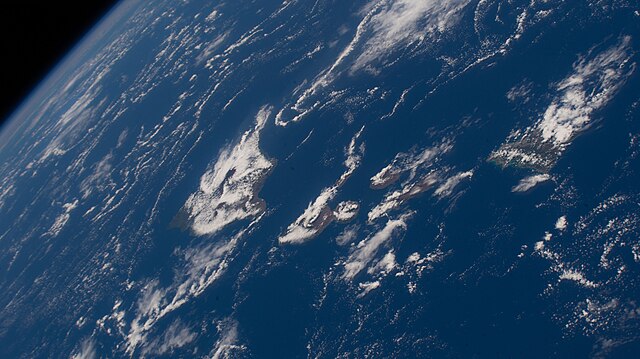Niʻihau, anglicized as Niihau, is the westernmost main and seventh largest inhabited island in Hawaii. It is 17.5 miles (28.2 km) southwest of Kauaʻi across the Kaulakahi Channel. Its area is 69.5 square miles (180 km2). Several intermittent playa lakes provide wetland habitats for the Hawaiian coot, the Hawaiian stilt, and the Hawaiian duck. The island is designated as critical habitat for Brighamia insignis, an endemic and endangered species of Hawaiian lobelioid. The United States Census Bureau defines Niʻihau and the neighboring island and State Seabird Sanctuary of Lehua as Census Tract 410 of Kauai County, Hawaii. Its 2000 census population was 160, most of whom are native Hawaiians; its 2010 census population was 170. At the 2020 census, the population had fallen to 84.
Aerial view of Niʻihau looking southwestward from the northeast
View of the rugged cliffs of windward Niʻihau (the northeastern shore)
A group of villagers at Puʻuwai Beach settlement, Niʻihau in 1885. Photograph taken by Francis Sinclair, son of Elizabeth McHutchison Sinclair.
Navy contractors from PMRF arrive at Paniau Ridge on Niʻihau in an Agusta A109 helicopter. The seabird sanctuary island of Lehua can be seen in the background.
Hawaii is an island state of the United States, in the Pacific Ocean about 2,000 miles (3,200 km) southwest of the U.S. mainland. It is the only state not on the North American mainland, the only state that is an archipelago, and the only state in the tropics.
Pāhoehoe (smooth lava) spills into the ocean, forming new rock
French Frigate Shoals, located in the Northwestern Hawaiian Islands, is protected as part of the Papahānaumokuākea Marine National Monument.
Nā Pali Coast State Park, Kauaʻi
Partly cloudy conditions and a gentle breeze at 1:43 PM HDT; north is oriented towards the lower right in this photo taken from the International Space Station on June 24, 2022








